
The beautiful sunbird, formerly placed in the genus Nectarinia, is a sunbird. It is native to tropical Africa, its range extending from Senegal and Guinea in the west to Sudan, South Sudan, Ethiopia and Kenya in the east.
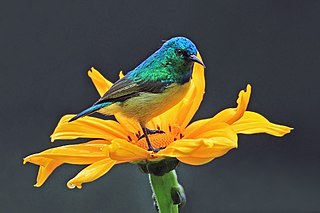
The collared sunbird is a bird species of the family Nectariniidae. The sunbirds are a group of very small Old World passerine birds which feed largely on nectar, although they will also take insects, especially when feeding young. The collared sunbird is in fact mainly insectivorous.

The olive-backed sunbird, also known as the yellow-bellied sunbird, is a species of sunbird found from Southern Asia to Australia.

The purple sunbird is a small bird in the sunbird family found mainly in South and Southeast Asia but extending west into parts of the Arabian peninsula. Like other sunbirds they feed mainly on nectar, although they will also take insects, especially when feeding young. They have a fast and direct flight and can take nectar by hovering like a hummingbird but often perch at the base of flowers. The males can appear all black in harsh sunlight but the purple iridescence is visible on closer observation or under good light conditions. Females are olive above and yellowish below.
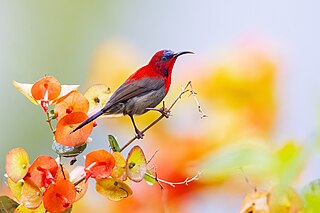
The crimson sunbird is a species of bird in the sunbird family which feed largely on nectar. They may also take insects, especially when feeding their young. Flight is fast and direct on their short wings. Most species can take nectar by hovering like a hummingbird, but usually perch to feed. It has also been unofficially announced as Singapore’s national bird by the Nature Society Singapore.

Loten's sunbird, also known as the long-billed sunbird or maroon-breasted sunbird, is a sunbird endemic to peninsular India and Sri Lanka. Named after Joan Gideon Loten, who was the Dutch governor of colonial Ceylon, it is very similar to the purple sunbird that is found in the same areas and also tends to hover at flowers for nectar, but can be distinguished by the longer bill, the maroon band on the breast and brownish wings. Like other sunbirds, it is also insectivorous and builds characteristic hanging nests.

The Seychelles sunbird is a small passerine from the sunbird family. It is named after the French explorer Jean-Jacques Dussumier. It is native to the Seychelles, where it is known as kolibri in Seychellois Creole. This bird is placed in the genus Cinnyris by some authorities and in Nectarinia by others. Although this bird has a limited range, it is described as common and has a stable population, so the International Union for Conservation of Nature has rated its conservation status as being of "least concern".

The orange-breasted sunbird is a species of small, predominantly nectar-feeding bird that is endemic to the fynbos shrubland biome of southwestern South Africa. It is the only member of the genus Anthobaphes, in the family Nectariniidae, though it is sometimes placed in the genus Nectarinia. The birds are sexually dimorphic, with females being olive green while the males are orange to yellow on the underside with bright green, blue and purple on the head and neck.
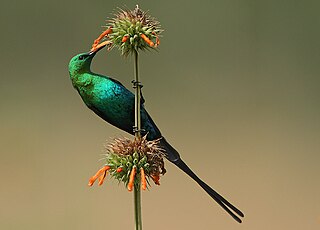
The malachite sunbird is a small nectarivorous bird found from the highlands of Ethiopia southwards to South Africa. They pollinate many flowering plants, particularly those with long corolla tubes, in the Fynbos.

The elegant sunbird is a large, up to 12 cm long, Australasian sunbird in the genus Aethopyga. The male has an iridescent blue-green crown, shoulder patch and uppertail coverts, yellow bar across lower back, red ear coverts, olive back, yellow throat, red neck collar and yellow below. The female has a yellowish olive upperparts, scaly crown and yellow underparts.
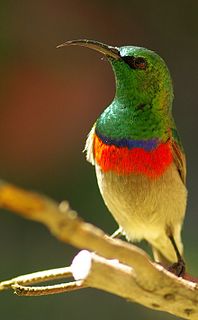
The southern double-collared sunbird or lesser double-collared sunbird is a small passerine bird which breeds in southern Africa. It is mainly resident, but partially migratory in the north-east of its range.
The Rwenzori double-collared sunbird, also called Stuhlmann's sunbird or the Rwanda double-collared sunbird, is a species of bird in the family Nectariniidae. It is found in the Ruwenzori range of mountains in south central Africa. Its natural habitat is subtropical or tropical dry forests. It is threatened by habitat loss. It is sometimes considered to be a subspecies of the greater double-collared sunbird. Some authors consider this bird to be part of a species complex with Cinnyris afer, where it joins Ludwig's double-collared sunbird and Prigogine's double-collared sunbird. As with other closely related species, each inhabiting different locations, there are subtle similarities and differences between the local populations, and their taxonomic treatment depends on the views of the taxonomist.

The souimanga sunbird is a small passerine bird of the sunbird family, Nectariniidae. It is native to the islands of the western Indian Ocean where it occurs on Madagascar, the Aldabra Group and the Glorioso Islands.
The Amani sunbird is a species of bird in the family Nectariniidae. It is found in Kenya and Tanzania. Its natural habitats are subtropical or tropical moist lowland forests and subtropical or tropical moist montane forests. The male Amani sunbird has a white and dark-green feathered body while the female Amani sunbird has a yellow and grey plumage. Breeding season takes place from May to June and from September to December. The regular diet of the Amani sunbird consists of spiders, caterpillars and other flying insects. It is threatened by habitat loss.

The pygmy sunbird is a species of bird in the family Nectariniidae. It is found in Benin, Burkina Faso, Cameroon, Central African Republic, Chad, Democratic Republic of the Congo, Ivory Coast, Ethiopia, Gambia, Ghana, Guinea, Guinea-Bissau, Kenya, Mali, Mauritania, Niger, Nigeria, Senegal, Sierra Leone, Sudan, Togo, and Uganda.
Moreau's sunbird is a species of bird in the family Nectariniidae. It is endemic to Tanzania where its natural habitat is subtropical or tropical moist montane forests. It is threatened by habitat loss and the International Union for Conservation of Nature has assessed it as being "near-threatened".

The golden-winged sunbird is a species of bird in the family Nectariniidae. Three subspecies are recognised. It is found in Democratic Republic of the Congo, Kenya, Tanzania, and Uganda.
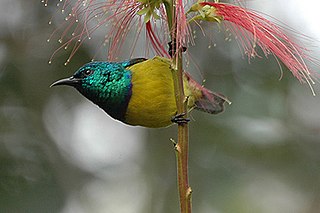
Hedydipna is a genus of sunbirds. It contains the following species, which are sometimes included in genus Anthreptes.

Temminck's sunbird is a species of sunbird. It is found in up to 1800 m altitude in Borneo, Sumatra, Malaysia, and south west Thailand in tropical moist montane forests.
H. metallica may refer to:


















